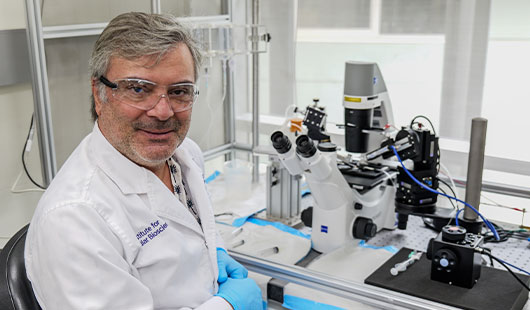University of Queensland researchers have uncovered the workings of ant venom by measuring electric currents through individual channels in cells to understand how it causes pain.
Dr Angelo Keramidas from UQ's Institute for Molecular Bioscience led a team which studied the potent sting of the West African ant (Tetramorium africanum), discovering a toxin within the venom caused hyperstimulation of sodium channels within the victim's cells which led to extreme pain.
"This ant bite causes a cacophony of pain symptoms, not only severe and long-lasting pain with reddening and inflammation at the sting site but also excessive sweating and goosebumps," Dr Keramidas said.
"We identified the characteristics of this toxin using electrophysiology and pharmacology, with equipment so sensitive it can record electrical currents passing through single sodium channels."
The African ant species is confined to tropical western and central African countries - from Guinea to Zaire - with the pain symptoms like that of the Australian green-head ant.
"We're also keen to find out if this mechanism is found in the venom of other ants, as well as insects like wasps and bees," Dr Keramidas said.
"This research is part of a larger project to understand how the venom causes pain on a molecular level.
"It can help us to develop new ways to treat acute and chronic pain."
 The team has previously shown that ant toxins bind to sodium channels - proteins embedded in the cell membrane of the nerve cells.
The team has previously shown that ant toxins bind to sodium channels - proteins embedded in the cell membrane of the nerve cells.
"Using electrophysiology, we were able to see that the toxin binds to the sodium channel and hijacks the channel's built-in activation mechanism, causing hyperactivity," Dr Keramidas said.
"There was a rush of negative ions attracted to the channel and a repelling of positive ions which caused the hyperactivity of the sodium channel to amplify - a phenomenon we'd never seen before.
"This hyperactivity causes continuous firing of the pain signal, explaining the ferocity of the ant sting.
"The venom activates multiple channels in the nerve cell membrane, and they remain active for a very long time and can't be reset.
"We believe this overstimulation eventually causes numbness at the sting site."
The research was published in the Journal of Biological Chemistry.
Image above left: Dr Angelo Keramidas from UQ's Institute for Molecular Bioscience.
Media contact
IMB Communications






